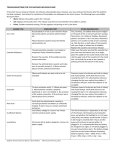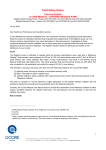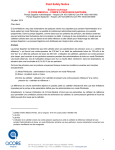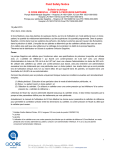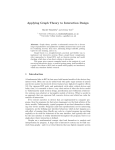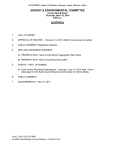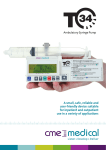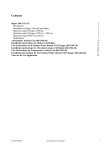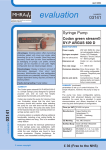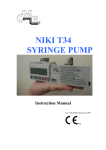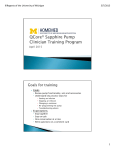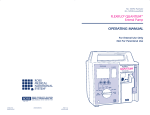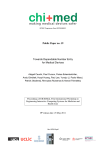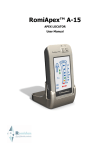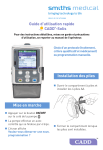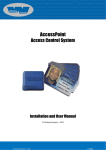Download Field Safety Notice
Transcript
Field Safety Notice Technical Bulletin Q CORE MEDICAL - SAPPHIRE INFUSION PUMP Sapphire Multi-Therapy Pump – Hospira L/N xxxxxx /Q Core P/N xxxxxx Sapphire Epidural Pump – Hospira L/N xxxxxx /Q Core P/N xxxxxx 16 July 2015 Dear Healthcare Professional and Valuable Customer, Q Core Medical has received complaints from a few customers that when using Epidural mode with patient bolus the amount of medication delivered may be greater than programmed. In the Sapphire pump, as in all infusion systems, external factors may cause fluctuations in flow-rate accuracy. Investigation of these complaints determined that the catheters used in these cases were of a gauge smaller than that used for the Sapphire pump flow-accuracy calibration. The Sapphire Infusion System is distributed by Hospira or their distributors in your country. Cause The Sapphire pump is calibrated to operate within its accuracy specifications when used with a 'Reference Catheter1' that provides a back pressure of 0.32 bar 2 at 125 mL/h bolus delivery rate and 0.57 bar 3 at 200 mL/h bolus delivery rate. Using catheters that create a lower back-pressure may result in over-delivery during Epidural treatments with patient bolus. The actual deviations that occurred during clinical use with either flow rate, as reported in the complaints, were within the range of 0.5-8.8 % over-delivery. This deviation in accuracy may occur only when all of the following conditions are concurrently fulfilled: (1) Epidural mode: Running an infusion in the Epidural delivery mode; (2) Bolus: The patient is given a patient bolus; (3) Catheter selection: Using a catheter with a back-pressure that is lower4 than the back-pressure of the 'Reference Catheter'. The extent of deviation in volume delivered is highly dependent on the catheter selected, together with the limitations imposed by the pump and the parameters set for the Epidural treatments. Currently, the Q Core Medical User Manual does not include the parameters of the Reference Catheter to allow precise correlation between the catheter dimensions, the back-pressure and the deviation in flow that the catheter may cause. Risk to Health No patient injuries or deaths have been reported as a result of this issue. Although Epidural drugs may lead to adverse effects such as respiratory depression, Q Core's investigation determined that there are no increased risks to health as a result of the over-deliveries reported. 1 Smiths Medical Portex catheter, 20 G, length 915 mm (product code 100/382/118). 4.35 PSI. 3 8.26 PSI. 4 Using a catheter with back-pressure higher than the Q Core Medical Reference Catheter, while using Epidural mode with patient bolus, leads to under-delivery. There have been no complaints regarding under-delivery. 2 1 Field Safety Notice Technical Bulletin Q CORE MEDICAL - SAPPHIRE INFUSION PUMP Sapphire Multi-Therapy Pump – Hospira L/N xxxxxx /Q Core P/N xxxxxx Sapphire Epidural Pump – Hospira L/N xxxxxx /Q Core P/N xxxxxx Action Taken by the Company To address this issue, Q Core Medical is providing an addendum to the User Manual (attached to this notification), to assist customers in (i) identifying whether the catheter utilised may cause over-delivery, (ii) better understanding the effect of back-pressure and catheter size on the accuracy of the delivered volume, (iii) translating the catheter’s back-pressure to the degree of flow deviation that can be expected and (iv) contacting Q Core ([email protected]) to determine if and to what extent specific catheter/pump combinations are susceptible to over-delivery. Future versions of the User Manual will incorporate the information contained in the addendum. Actions to be Taken by the User 1. Inform: Inform the healthcare professionals in your organisation about this notification and provide them with a copy of the notification. 2. Add the Addendum to your User Manual: Photocopy a sufficient number of the attached Addendum and add a copy to each Sapphire Infusion Pump User Manual in your healthcare facility. 3. Adjust bolus and basal flow rates: If a catheter size smaller than 20 gauge is used, and overdelivery is experienced during utilisation of Epidural mode with patient bolus: A. Restrict the programmed flow rate for bolus delivery to 125 mL/h (not 200 mL/h). If the treatment is programmed to 'bolus only' infusion, the highest deviation that can occur is 12 % at 125 mL/h. And B. When clinically applicable, use a basal rate of at least 1 mL/h. Any basal rate that is larger than zero will reduce the amount of over-delivery. Note: Over-delivery can be further reduced or eliminated by: (1) Restricting the number of boluses administered; and/or (2) Restricting the volume infused during boluses; and/or (3) Programming a basal flow rate over 1 mL/h. (4)For optimal flow accuracy use a 20-gauge Epidural catheter where suitable. 4. Complete the Customer Response Form: A. Complete the attached response form; B. Return the form to the Q Core service department via the e-mail address included on the form. Please do so even if you do not have an affected product. 2 Field Safety Notice Technical Bulletin Q CORE MEDICAL - SAPPHIRE INFUSION PUMP Sapphire Multi-Therapy Pump – Hospira L/N xxxxxx /Q Core P/N xxxxxx Sapphire Epidural Pump – Hospira L/N xxxxxx /Q Core P/N xxxxxx Enquiries and Support: Catheter Enquiries: If further assistance is required to determine (i) whether the catheter you are using may result in over-delivery during Epidural infusion with a patient bolus; or (ii) the estimated effect that the catheter may have in over-delivery, please contact [email protected], or mark the appropriate box in the attached customer response form. For other enquiries, please contact Hospira using the information provided below: Hospira Contact Contact information xxxxxx xxxxxx Tally Eitan President Q Core Medical Ltd. 3 Field Safety Notice Technical Bulletin Q CORE MEDICAL - SAPPHIRE INFUSION PUMP Sapphire Multi-Therapy Pump – Hospira L/N xxxxxx /Q Core P/N xxxxxx Sapphire Epidural Pump – Hospira L/N xxxxxx /Q Core P/N xxxxxx RESPONSE IS REQUIRED Please e-mail the completed form to [email protected]. Customer Information ____________________________________________ ___________________________ Business Name Hospira Customer Number (if applicable) ________________________________________________________________________ Address/Town/City/County/Region/Postcode ________________________________________________________________________ Contact Name/Phone/E-mail Address ________________________________________________________________________ Completed by: Printed Name/Signature/Date Actions to be taken: For Hospitals I have received and read the letter dated 16 July 2015 and have provided a copy to each of the users in the facility: YES NO - If NO, state the reason: ___________________________________________________________ I have copied and attached the Addendum to each Sapphire Infusion Pump User Manual in my healthcare facility: YES NO - If NO, provide the date when this will be completed: ___________________________ If further assistance is required in determining whether the catheter used may result in over-delivery during delivery with Epidural mode with a bolus, or in calculating the impact that the catheter may have in over-delivery, please contact [email protected], or tick this box 4 ADDENDUM: USER MANUAL SAPPHIRE MULTI-THERAPY AND DEDICATED INFUSION PUMPS Changes to Chapter 5: 'Using the Infusion Modes', clause: 'Epidural Mode' The following replaces the section between the title 'Epidural Mode' and the warning 'Epidural Mode: Safety Precautions'. The updated text is marked in bold: "This mode enables the pump to deliver epidural infusions. Epidural administration is limited to short term infusions (up to 96 hours), using indwelling catheters specifically identified for epidural drug delivery. In Epidural infusion mode, the pump can operate in either of the following sub-modes: • • PCEA (Patient Controlled Epidural Analgesia): Delivers epidural boluses, either alone or in addition to a basal preset rate. Alternatively, only a basal infusion (without boluses) can be programmed. Intermittent Epidural: Delivers epidural infusions at intermittent pre-set intervals. The features of the Epidural mode are designed to accommodate the special requirements of an epidural infusion, such as lower VTBI, lower infusion rate, and higher backpressure. In Epidural intermittent mode, bolus rate is set to 125 mL/h. In PCEA mode, bolus rate can be configured to 125 mL/h or 200mL/h before starting infusion (for details refer to Epidural Mode Options Menus on Chapter 7). For details about the impact of different back pressures on pump delivery caused by different catheter sizes when used in Epidural mode, refer to pump accuracy in Chapter 12". Changes to Chapter 12: 'Technical Specifications', clause: 'Pump Accuracy' The following section replaces the entire section titled 'Pump Accuracy'. The updated text is marked in bold: "The following graphs and curves were derived from the pump accuracy testing procedures described in the IEC60601-2-24 standard. Testing was performed under normal conditions (specified in IEC60601-224 standard) at room temperature (25°C, 72°F). Normal conditions to ensure optimal accuracy of +/-2.5%: • • • • • Fluid level should be 50 cm above the pump No back pressure due to catheter size or difference in height of pump and infusion site Room temperature (25°C) Barometric pressure of sea level altitude (101 kPa) IV medication with water like fluid characteristics 5 ADDENDUM: USER MANUAL SAPPHIRE MULTI-THERAPY AND DEDICATED INFUSION PUMPS Epidural Mode: the operating conditions to ensure optimal accuracy of +/-2.5% while utilizing an Epidural catheter are: • • Use of catheter that creates a back pressure of 0.32 bar (4.35 PSI) at 125 mL/h and 0.57 bar (8.26 PSI) at 200 mL/h. This back pressure is typical for 20 gauge catheters, that usually have an internal diameter of 0.45 or 0.46 mm. Catheters with gauge size smaller than 20 may create over delivery, and catheters with gauge size larger than 20 may create under delivery. In the Sapphire pump, as in all infusion systems, external factors may cause fluctuations in rate accuracy. Conditions that can cause flow fluctuations include: Position of the infusion container height (any deviation from 50 cm above the pump). Fluid characteristics that deviate from water-like characteristics, such as density, viscosity and homogeneity. Positive and negative pressure, including back pressure. Environmental temperature above or below 25°C and barometric pressure above or below 101kPa For example: A change of +/- 25 cm in the fluid level above the pump may result in deviation in accuracy of +/- 1%. A change of +/-0.05 bar in back pressure may result in deviation in accuracy of +/-3%. Using sets with PAV may result in deviation in accuracy of -6%. Note 1: In Epidural mode, the inner diameter of the catheter as well as the tubing length may create back pressure that impacts the accuracy of the pump, and to a lesser extent so may the fluid viscosity. Under delivery or over delivery that may occur due to a change in catheter size, may be estimated based on the following formulas: % 𝒅𝒆𝒗𝒊𝒂𝒕𝒊𝒐𝒏 𝒂𝒕 𝟏𝟐𝟓 (−𝟑%) 𝒎𝑳 𝒎𝑳 = (𝒃𝒂𝒄𝒌 𝒑𝒓𝒆𝒔𝒔𝒖𝒓𝒆 𝒐𝒇 𝒄𝒂𝒕𝒉𝒆𝒕𝒆𝒓 [𝒃𝒂𝒓] 𝒂𝒕 𝟏𝟐𝟓 − 𝟎. 𝟑𝟐 [𝒃𝒂𝒓]) ∗ 𝒉 𝒉 𝟎. 𝟎𝟓 [𝒃𝒂𝒓] % 𝒅𝒆𝒗𝒊𝒂𝒕𝒊𝒐𝒏 𝒂𝒕 𝟐𝟎𝟎 (−𝟑%) 𝒎𝑳 𝒎𝑳 = (𝒃𝒂𝒄𝒌 𝒑𝒓𝒆𝒔𝒔𝒖𝒓𝒆 𝒐𝒇 𝒄𝒂𝒕𝒉𝒆𝒕𝒆𝒓 [𝒃𝒂𝒓] 𝒂𝒕 𝟐𝟎𝟎 − 𝟎. 𝟓𝟕 [𝒃𝒂𝒓]) ∗ 𝒉 𝒉 𝟎. 𝟎𝟓 [𝒃𝒂𝒓] For example, if the backpressure for the catheter in use is 0.2 bar (2.9 PSI) at 125mL/h, the resulting % deviation = 7.2% 6 ADDENDUM: USER MANUAL SAPPHIRE MULTI-THERAPY AND DEDICATED INFUSION PUMPS If the back pressure of the catheter used is unknown, please consult the set manufacturer. You may also contact Q Core Medical Support at [email protected], and Q Core will either measure or calculate the back pressure and/or deviation according to the provided parameters. Practical recommendations: If using a catheter size smaller than 20 gauge and over-delivery is experienced during Epidural mode with patient bolus: A. Restrict the programmed flow rate for bolus delivery to 125 mL/h (not 200 mL/h) If the treatment is programmed to bolus only infusion, the highest deviation that can occur is 12% at 125 mL/h. And B. When clinically applicable, use a basal rate of at least 1 mL/h. Any basal rate that is larger than zero will reduce the over-delivery. Note: Over-delivery can be further reduced or eliminated by (1) Restricting the number of boluses administered; and/or (2) Restricting the volume infused during boluses; and/or (3) Programming a basal flow rate to more than 1 mL/h. (4) For optimal flow accuracy use a 20 gauge Epidural catheter where suitable Note 2: When using accessories where the container height deviates from 50 cm above the pump, there may be deviations in pump accuracy (e.g., PCA Lockboxes and the Homecare Large Backpack)". 7







